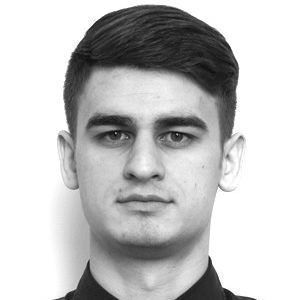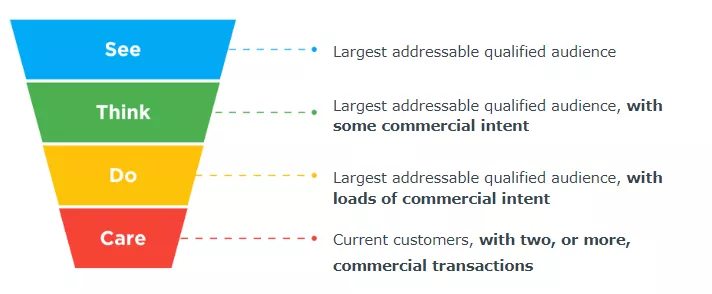Kentavar.bg PPC Case Study – How PPC Helped to Increase Brand Traffic by 268% in Two Years
Clients often expect immediate results after employing the services of an agency. Therefore, specialists choose tools which drive the most conversion, such as search campaigns and shopping campaigns. These tools are aimed at users who are at the lower funnel stages of 'do' and 'care' alongside an active and interested audience.
Sales Funnel — See Think Do Care
However, the potential of such conversion campaigns is quickly exhausted, since only 15% of an audience are active consumers. The remaining 85% ('see' and 'think' stages) are potential consumers. It’s still important to work with them as the synergistic effects can help to drive clients even if the advertising is disabled or advertising costs are decreased — users will still buy products or services because they know of a company.
The perfect tool for working with a passive audience is GDN. This is the tool we utilized when we needed to expand advertising. Although initially display campaigns had to drive conversions to a site, we also kept in mind that GDN would allow us to reach a wider audience and subsequently convert them into clients. This is also known as branding.
Branding is a targeted marketing practice of creating long-term goods preferences among consumers.
To make branding work efficiently, a project must meet the following requirements:
- individual corporate style and features which differentiate a product from competitors' products;
- a user-friendly and optimized site (especially for mobile devices);
- presence of a company page in social networks and the possibility of contacting the company.
There are 3 levels of brand awareness. Ad performance indicators vary upon the level of brand awareness:
1. Brand recognition is the weakest level of brand awareness. It refers to the ability of consumers to correctly differentiate the brand when they come into contact with it.
2. Brand recall refers to the ability of consumers to correctly elicit a brand name from memory when prompted by a product category.
3.Top of mind refers to the first few brands which come to mind when consumers are prompted by a product category. A consumer usually buys products from one of these brands.
Let's take a look at GDN campaigns in the context of a car sales website Kentavar.bg.
Tool: Google Ads
Result: brand traffic increased by 268%
Period: July 2016 to June 2018
Keep in mind that the brand had already existed — we didn’t create it.
We launched that same display network campaigns as mentioned above. When creating display ads, it’s crucial to use brand colors, logos and name in ads headings and descriptions.
Then, we created a brand search campaign. This was not an easy task since launching a brand campaign in Google Ads is quite a controversial subject. Some specialists see no point in launching such campaigns. The clients tend to ask a reasonable question — why spend extra money on a brand search campaign if the site is shown first when searching for a brand?
Typically, there are three arguments in favor of brand search campaigns:
- Protecting brand traffic — you never know if or when a competitor decides to launch campaigns on your brand search, a common practice nowadays.
- Increasing the number of relevant first-page search results. This could displace other sites with negative reviews about the company from the top ten search results.
- Tracking brand queries number increase since Search Console data are disembodied, and a lot of search queries are often hidden in «not set».
As soon as we launched display advertising, the number of impressions and reach showed continuous growth.
A comparison of the reach indicators between the first three months after the campaign launch (July — September 2016) with the same period in 2017.
A comparison of the reach indicators between July to September 2016 and April to June 2018.
This positively affected the quantity of brand traffic — it increased as time went on.
Dynamics of brand search campaign traffic growth
Brand traffic was increased by (18669/6968)*100% = 268%.
Conclusion
By using a display campaign, we successfully increased brand awareness, which can be easily assessed by launching a search campaign with brand queries. In 99% of cases, brand search campaigns produce conversions at a lower cost than other search campaigns. In this project, the CPA was 5.5-fold lower than the CPA of other search campaigns, and the conversion rate was more than two-fold higher.
One might say that to produce such results, funds are needed to launch the display campaign. So, did the display campaign pay off? The answer to this question is a comparison of the total CPA of display and brand campaigns to an average CPA of search campaigns for July 2016 to June 2018.
Ultimately, yes, the display campaign paid off. The display advertising launch enabled us to get conversions at 1.82-fold lower price compared to the conversion cost of search advertising campaigns.
Related Articles
What Is a URL Slug, and How Do You Make It SEO-Friendly?
Let's figure out how to make URL slugs understandable for users and search engines and how to implement simple changes that will improve page visibility
Five Steps to Building a Keyword List and Clustering Keywords
In this article, I'll show you how to identify and group keywords in a way that will effectively attract your target audience
Amazon Dynamic Bidding: The Strategy and Psychology Behind Top Brands
Dynamic bidding on Amazon isn’t just another checkbox in your campaign settings; it’s the difference between throwing money at the Amazon advertising wall and orchestrating a symphony of strategic bid adjustments that separate the pros from the pretenders







